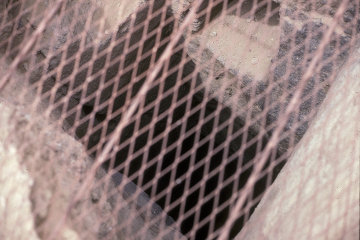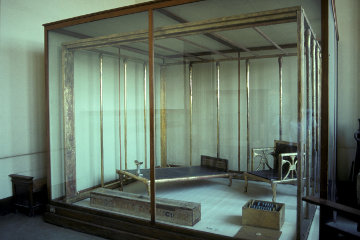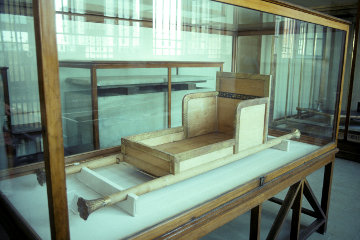Reisner and the re-buried Queen
George Andrew Reisner (1867-1942) came from the mid-west of America and graduated from Harvard University with degreees in Semitic languages. As happens with many students, however, by the time he had finished at college his interests had changed and from Semitic languages, found in Palestine and Mesopotamia, he was attracted to Egypt and its language. He went off to Berlin to study under the philologists Alodph Erman and Kurt Sethe.
With this under his belt he returned to America and was picked up by his alma mater to pioneer a course in Egyptian language. A year later he made his first visit to Egypt where he was part of an international commission writing a complete catalogue of the contents of the Cairo Museum. After the publication of the third volume of the "Catalogue General" he transferred his activities to the field of archaeology, working at Naga ed-Der, Ballas and Gizeh in work paid for by Phoebe Hearst, mother of the newspaper tycoon William Randolph Hearst.

| |
| George Reisner (standing, with pipe) and members of his staff at their site office in Gizeh. |
In 1904 the Hearst sponsorship came to an end but Harvard University wanted to run its own expeditions and naturally turned to someone they knew to head the work. Reisner began his life-long involvement with the Gizeh plateau and the tombs surrounding the pyramids there. The area was divided into three concessions, given to the Italians, Germans and Americans. Reisner and his team worked on the mastabas surrounding the Great Pyramid, which belonged to officials of the Fourth Dynasty court of Pharaoh Khufu.
It would take too long to tell of all the discoveries made by the Harvard University expedition over the next twenty years, which included many mastabas, the causeway and valley temple of Mycerinus, and side expeditions to other sites in Egypt and the Sudan. In 1925, however, the most significant of Reisner's many discoveries was made - and ironically Reisner was for once not in Egypt!
On February 2 of that year Alan Rowe and T. Greenlees, two of his assistants were at work among the mastabas east of the Great Pyramid. The site had been carefully brushed and arranged and the expedition photographer, Moham-medani Ibrahim, was about to photograph the progress of the work. Even today, with small cameras and fast film, archaeological photographers still prefer to set the camera firmly on a tripod; back then, when cameras were the size of a small suitcase and used glass plates instead of film, a tripod was essential. Ibrahim carefully set up the tripod, levelled the camera and put his head under the black cloth in order to compose the picture.
To his astonishment, the picture shown on the glass screen was slowly tilting to the left. In the moment or two it took him to realise that something was wrong the tilt suddenly speeded up and Ibrahim only just ducked out from under the black cloth in time to grab the camera before the precious instrument crashed to the ground. Attracted by his yell of alarm, Rowe and Greenlees hurried up and the three men examined the ground to find out what had happened.
The three legs of the tripod had been carefully set up on the solid limestone of the plateau, but inexplicably one of them had begun to sink down into the rock! The men poked at the rock to try and ascertain why it had crumbled and at almost the same moment all three realised that it wasn't rock at all, but ancient plaster! They called for a brush and began to carefully sweep the area and found that there was a large square of plaster - obvious once they knew what they were looking for.

| |
| The shaft leading down to the tomb of Queen Hetepheres was originally filled with blocks of stone. |
The three men hastily completed their photography and then Lowe and Greenlees sent for a gang of workmen and began to clear the area. They found that the plaster blocked a vertical shaft that was carefully filled with a mass of masonry. Nearby there was another carefully sealed shaft cut in the rock which turned out to be twelve steps that led down through a rock-cut doorway into the first shaft. Any hopes that it might emerge under the stone blocking were dashed: the doorway opened onto more masonry.
It took the workmen two weeks of unremitting toil to remove the thousands of stones that blocked the 90-foot deep shaft. About a third of the way down they found a small hole that contained some ox bones showing clear signs of butchery, two beer jars and some charcoal. These were obviously the remains of a funerary feast, possibly left in the shaft as offerings for the dead.
The untouched blocking of the shaft raised hopes that there might be an unopened tomb at the bottom and these hopes were heightened when finally they removed the last stone at the bottom of the shaft and found a sealed doorway that obviously led into a tomb chamber. With Reisner not due back for another four months, the two men would have been more than human if they had not opened the tomb. They carefully chipped away some of the plaster blocking and called for a mirror with which to reflect sunlight into the tomb.
Taking it in turns to look, they identified various items of furniture made of wood decorated with gold leaf, a variety of vessels and containers, and right in the middle of the chamber, a gleaming alabaster sacrophagus on which were several sheets of gold inlayed with faience hieroglyphics. Straining their eyes, the two men tried unsuccessfully to read them. All they could recognise was a cartouche, sufficient to indicate the likelihood that the owner of the tomb might be royal - and its proximity to the Great Pyramid raised the exciting possibility that this might be the missing burial of the great pharaoh Khufu.
At this point their consciences got the better of them and Lowe and Greenlees ordered that the doorway be re-sealed and left until Reisner, the director of the expedition, returned from his trip to America.

| |
| A reconstructed bed and chair from the tomb of Queen Hetepheres are arranged under the portable canopy that shaded them. The cloth which covered the frame is in another case nearby. Notice the neck-rest on the bed. |
Reisner arrived in Gizeh in July and at once set to work on the new discovery. It was typical of the man that he did not re-open the tomb until he had thoroughly studied the notes and photographs made by his assistants (whose record-keeping was as meticulous as his own!) Finally he allowed himself to be lowered down the shaft and removed the blocking in the doorway, to reveal the rather small and clearly unfinished chamber beyond.
The first task was to organise some form of lighting as it was simply not possible to work adequately by reflected sunlight! To the intense disappointment of all concerned, the wonderful wooden furniture literally turned to dust when it was touched. The conservators were obliged to reconstruct the objects using the careful measurements made by the excavators, with modern wood to hold the gold decorations. Any carvings that there may have been in the wood itself were gone forever.
It took two years of hard work to clear the tomb of all its objects. Often the team were reduced to picking up fragments of gold leaf with tweezers in the hope that they could eventually be joined together to reconstruct the original pattern. There were also stone and bronze objects, artefacts that could only be described as "ritual objects", and a treasure trove of jewellery made of gold and precious stones.
By this time the hieroglyphics had been translated and any hopes that this might be Khufu's burial had been dispelled. However it was the next best thing: it was the royal burial of Khufu's mother, Queen Hetepheres, wife of Sneferu, the builder of the Red and Bent Pyramids.

| |
| The reconstructed sedan chair in which Queen Hetepheres was carried. |
Finally all that remained was the alabaster sarcophagus; its seals were intact but there was a small, unexplained chip out of the lid. Reisner invited a select group of notables that included a few journalists, the Director General of Antiquities and the American Ambassador, to the ceremonial opening. The lifting tackle was attached to the lid and it was slowly and carefully raised. The first to peer into the three-thousand year old sarcophagus was Joseph Lindon Smith, an artist specialising in recording Egypt's past and a personal friend of Reisner. For a moment he stared with unbelieving eyes at the empty interior and then, with a singularly unhappy turn of phrase, he exclaimed, "George, she's a dud!"
It took a short while for the meaning of his words to sink in, by which time the lid had been raised sufficiently for the others to see inside and also realise that the sarcophagus was empty. Reisner masked his disappointment by quipping, "Gentlemen, I regret that Queen Hetepheres is not receiving."
To this day no one has adequately explained the mystery of the intact burial and the empty sarcophagus. One explanation is that this was a false burial - a not unknown practice in ancient Egypt, where royalty might have an official tomb in the royal necropolis but be actually buried somewhere else, such as, for example, the sacred site of Abydos where proximity to Osiris, the god of the underworld, was thought to ensure a better reception in the land of the dead. However the 90 feet of carefull blocking, as well as the richness of the objects found in the tomb rather indicate that this was the real tomb.
Reisner himself came up with what is probably the best explanation. He suggested that Queen Hetepheres was originally buried near her husband in Dashur or Meidum, but that shortly afterwards thieves got into the tomb and plundered it. The first object of a grave robber's attention was probably the mummy, which would be torn apart for its jewellery or even removed entirely to be robbed at leisure.
Khufu was informed that his mother's grave had been disturbed and promptly ordered that for greater security she should be reburied near his own pyramid complex. However no one dared to tell him that his mother herself was missing. Instead the priests quietly re-sealed the coffin and had it buried with all pomp and proper religious observance in its new tomb. To his dying day, Khufu probaby believed that his mother was safe and sound in her grave in the shadow of his mighty pyramid.
Today visitors to the Cairo Museum can see the treasures of Queen Hetepheres in a room just off the Tutankhamun corridors. In a huge glass case there is the reconstructed sedan chair, throne and portable pavilion of the queen, made of modern wood decorated with the original ancient gold trimmings. In small display cases round the walls of the room is the jewellery of the queen. It is a pity that so many people, overawed by the better known treasures of Tutankhamun fail to even notice the lesser trove of Hetepheres - or if they do see it, know nothing about the story of the tomb and its discovery.





